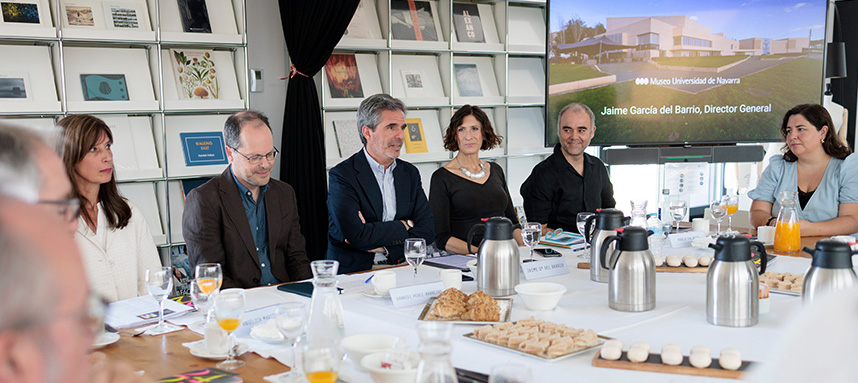The MUN opens its new era with the great challenge of attracting the public's attention
The Museo Universidad de Navarra presented its new artistic director, Gabriel Pérez-Barreiro, in Madrid. Two world premieres (with Jesús Carmona, and with Muriel Romero and Pablo Palacio, from Instituto Stocos) and the first and great exhibition of the Collection are the milestones of this season.

PhotoJoséJuan Rico/María Angélica Martínez, Gabriel Pérez-Barreiro, Jaime García del Barrio, Teresa Lasheras and Pablo Palacio.
Gabriel Pérez-Barreiro (A Coruña, 1970) has been appointed as artistic director of the Museo Universidad de Navarra. With extensive experience in university museums and other centers in Europe, the United States and Latin America, he is now the new head of the MUN's artistic strategy together with Teresa Lasheras, in charge of performing arts and music.
The general director of the Museum, Jaime García del Barrio, welcomed the new artistic director in a meeting with the media held in Madrid, in which he valued his incorporation as "a new step in what a university museum can do".
Pérez-Barreiro assumes this position after six years linked to the MUN as professor of the Master's Degree in Curatorial Studies. He presents himself as a person with teaching and research activity, so he sees his arrival as a boost to the rapprochement between these disciplines and art. The MUN has some very special characteristics," he confessed, alluding to the fact that the direction is divided between one person from the visual arts and another from the performing arts. -It's a great opportunity to learn and to ask ourselves questions.
As a university, the MUN allows us many luxuries of time, thought... The greatest of these luxuries is to be able to ask questions," he continued. -We have the university community, disciplines, knowledge and the opportunity to learn from what they tell us". In this process, he considers the Museum as "the great mechanism of the University to share knowledge with the public". In fact, he believes that "a museum should be a laboratory of artistic production", of interdisciplinary dialogue, and "a place of mediation with the public".
The Museo Universidad de Navarra is also distinguished by its collection, which is "unique, very well thought-out and well-founded," said the new artistic director. It is also the protagonist of the exhibition MUN Collection. The exhibition is structured around the donations that gave rise to its origin: the photographer Ortiz Echagüe and the Navarrese collector María Josefa Huarte; the successive incorporations, partly born of the artistic residencies project; and the evolution during the 19th century. Tender puentesand the evolution from the 19th to the 21st centuries with photographic, pictorial and sculptural works, as well as new formats such as video installations.
Thanks to this collection, professors at the University of Navarra also have the opportunity to carry out educational innovation projects with their students. This is what Professor María Angélica Martínez, from the School of Architecture, explained. And she exemplified it with the case of "El maletín de Tàpies", a project developed with students of the degrees of Architecture and Design, which aims to bring art to people with visual difficulties. Specifically, they worked with L'Esperit Català, by Antoni Tàpies. The proposal was part of the SociARTE project, which puts the Museum's resources at the service of social organizations, and was supported by Fundació Antoni Tàpies, ONCE and Fundació "la Caixa".

A moment of the meeting/© José Juan Rico
For her part, the director of Performing Arts and Music, Teresa Lasheras, explained the MUN's interest in "all those artistic projects that seek to give birth to new languages, technical reflections, formats and experiment with them" and in "new ways of linking artistic projects with audiences. We always want to be mediators, translators between artists and the public," he explained.
Museo en Danza is the cycle that brings together the contemporary dance proposals that the MUN brings each fall. Pursuing the dialogue between the arts and artistic disciplines, and between the arts and academic research, its seventh edition includes two world premieres: Súper viviente ( September 26) and Incubatio ( October 31).
Jesús Carmona brings to the MUN Súper viviente, a play that reflects on mental health, and which has the support of members of the patronage promoter and the sponsorship of Zurich insurance. To work on this show, Carmona has worked with a group of experts from the University, the Clinic and the Cima University of Navarra, belonging to psychiatry, psychology, neuroscience and art education. In addition, this Thursday 19 will hold a meeting with the public at the Museum, interviewed by two students from the University.
Instituto Stocos has also found a "great affinity" with this peculiar environment, as explained by Pablo Palacio, co-founder of the company together with Muriel Romero. Incubatio, in particular, combines dance, music, artificial intelligence (AI) models, virtual reality (VR) and motion capture techniques.
Museo en Danza is carried out in collaboration with INAEM, the Government of Navarra and the City Council of Pamplona. The shows QTA and Luz negra are also part of DNA - Festival de Danza Contemporánea de Navarra.